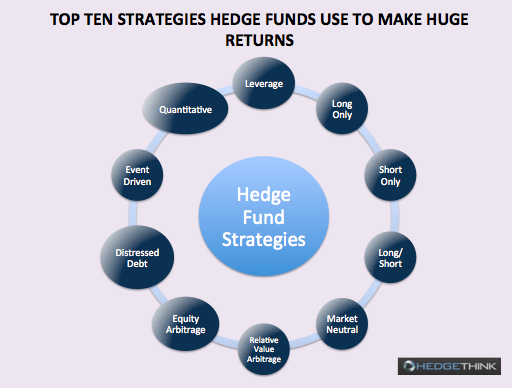Many people know hedge funds as the big brother of mutual funds. Mutual funds are riskier but they make more returns which is what makes them so attractive to the experienced investor. Hedge funds are only as good as the manager who is handling the investment and as a result a manager with a successful record charges more fees.
There is no specific strategy that works for making huge returns in hedge funds and most fund managers who have a successful track record usually have a few of them up their sleeves. Lets take a look at ten strategies that are commonly used in order to make huge returns:
1. Leverage
This is one of the riskiest strategies that can go wrong if the hedge fund doesnt make the expected returns. Using leverage or borrowing money for an investment in order to increase the returns is exactly what many strategies are made of. Investors borrow huge amounts of money for an investment that they are sure will make them huge returns and they would easily be able to return the money. However, all that goes horribly wrong when the market crashes. When used wisely, leveraging can help increase the returns. It is all about how much of leverage is being used.
2. Long Only
As the name suggests, the strategy here is about owning only long positions for a hedge fund whether in stocks or any other asset. The idea is to always set a long position so that when the hedge fund outperforms the benchmark, profit or alpha is generated.
3. Short Only
This is also a risky strategy and a difficult one as well. Using this strategy, a hedge fund only deals with short stocks. The idea is to short sell a stock that the manager is certain will go down. When the price does go down, you end up making a profit. However, if the market rises you will end up having to pay more than you invested and might lose it all.
4. Long/Short
This is a hybrid of short only and long only strategy and it works when a company holds a long position while selling stocks short as well. By holding a long position for those stocks that the manager is certain will go up, they are anticipating returns whereas by short selling stocks that they predict will go down, they will make a profit with these stocks as well. If both strategies work out, the hedge fund will make huge returns.
5. Market Neutral
This is a unique strategy where equal parts of the portfolio are invested in long positions and short positions. So, this brings the net exposure of a portfolio to 0 whereas the gross would be 100%. This allows a hedge fund to make substantial returns regardless of whether the market goes up or down.
6. Relative Value Arbitrage
How this strategy works is that the manager purchases two bonds with the same date of maturity as well as credit quality. However, the coupon price is different for both. The bond with the higher priced coupon will sell at a premium whereas the lower priced coupon will stay at par or below it. The manager then sells the bond with the premium and buys the below par bond. Both will eventually mature at par which allows for the coverage and the short sell of the premium bond.
7. Equity Arbitrage
This strategy usually works for the hedge funds that are looking for stocks from firms that are undergoing a takeover. They will short sell the stocks of the firm being taken over and hold a long position for the stocks of the company that is taking over. This is done with the assumption that the company being taken over will trade down and the company that is taking over will trade up.
8. Distressed Debt
This is a strategy which involves investing in the stocks of those companies that are currently in a distressed situation and as a result the value of their stocks has gone down. This is done with the belief that the reason the stocks have traded down is due to a financial situation which will eventually improve and the value of the stocks will go up. This will end up making huge gains for the hedge fund. Without doubt, this is a risky trade as the company might not come out of its distress and instead go further down.
9. Event Driven
Using this strategy, hedge funds invest in any stocks or equity that will move up and down with the market. However, the trick here is to look for any news that can make the market move up and down. If the manager has a lead time of even a few seconds, they can make huge returns from the markets movement.
10. Quantitative
This works by looking at ways a hedge fund can make profits because of market abnormalities. This is done by hiring computer programmers who analyze the statistical data to find hidden alphas. However, this strategy is risky and there have been more than a few historical cases where investors lost a large percentage of their asset value.
In the end, the type of strategy and how it works depends largely on the fund manager and how experienced or skilled he is at analyzing and predicting the market and making decisions that will prove successful in making huge returns.
Chris Turner is a versatile content writer with a passion for technology, finance, Investing and trading. He writes extensively on the subjects of Trading, Investing, Bitcoin, Forex trading, investing and general finance. He is writing and providing advice, education and encouragement to budding investors and traders, on Hedge Fund and alternative investments and other emerging financial trends. He is a contributor writer for HedgeThink.com and TradersDNA.com.




































